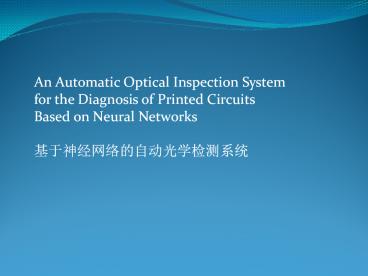An Automatic Optical Inspection System PowerPoint PPT Presentation
1 / 27
Title: An Automatic Optical Inspection System
1
An Automatic Optical Inspection System for the
Diagnosis of Printed Circuits Based on Neural
Networks ???????????????
2
- ???????????PCB??????,?????????????,??????????????
?????????????????????????????????????,????????????
????????????,??????????????????,??????????????????
????????????????????????,?????????????????????????
??????????,???????????????? - ?????????(Automated Optical Inspection)
- ????(Wavelets) ????(Neural Network)
- PCB?(Printed Circuit Bosrds diagnosis)?
3
?? PCB??????????????????????(electrical/contact
methods)???????????(non-electrical/non-contact
methods). ???????????????,???,????????????,??????
????????????,??????,???????????????????????(AOI)?P
CB?????????????????????????,????,????????????,????
???????????????,?????????,??????,?????????(Surface
Mounting Technology)??????????PCB????????????????
?????????????????????????AOI??,???????????,?????(F
uzzy Systems),????(Neural Networks)?????(Expert
System)????????????????????,??????CCD
???,???????????????
4
1?1??
- ????????????,??????????????CCD ???,??????PCB??????
?????X-Y???????????PCB???????????,????????????????
?????????????????????????????????????,????????????
????????????????????????(WaVelet Transform (WVT)
coefficients.)????????????????????????????????,???
????????????????????????? ?
5
- ? ???? (THE DIAGNOSIS APPROACH)
- ?????????????????,????????????????????????????????
?????????????????????????????????????????
?????????????????????AOI???,??????PCB?,????CCD???,
????????????????????????????????????????1?????????
??????????????,????????????????? ?
6
(No Transcript)
7
A. ????(Training procedure) ??????????????????????
?????????????????????????????????????????? A set
of neural networks are trained to diagnose all
the possible components. Each neural network is
trained using a set of patterns, corresponding to
the defects to be diagnosed on the corresponding
component.
8
B. ????(Testing procedure) ?????????PCB?,???CCD???
??????????????????????,????????,????????????????,?
?????????????????,????????????????????????????????
?????????????????????????????????,?????????,??????
??????,?????????????????? Given a board to be
diagnosed, a CCD camera acquires a circuit image.
This image is pre-processed to extract the
significant features, and then it is used as an
input to the set of neural networks previously
trained to recognize the defects on that circuit.
The outputs of the neural networks represent
the diagnosis of the system. The method used to
create the training set allows us to set the
diagnostic system before implementing the
production line. This is very useful, because it
reduces the cost of the diagnosis and allows us
to start the production line and the diagnostic
system simultaneously ?
9
? ?????????(THE DIAGNOSTIC SYSTEM
ARCHITECTURE) ??????????????2??????,??????????????
? A. ?????? (The Image Acquisition
System) ????X-Y?????????????CCD???????????????????
??????????????????CCD????????PCD???????????,??????
?????????????,???????????????,???????? ? An X-Y
positioning system supervises all the
displacements of the CCD camera. The dimension of
the framed region is controlled by modifying the
lens zooming. Wechose to move the CCD rather than
the PCBs in order to obtain a faster and more
flexible system, independent of the production
line. In this way the AOI is very useful not only
in the electronic industry but also in a wide
range of applications. In order to control the
illumination conditions, the acquisition system
is covered with black screens that avoid external
light sources.
10
B. ???(The Database) ????????????????????????????S
OL????,???????????????????????????????????????????
?????????????? ??????????????????????????????????,
??????????????????????????????????????????????????
????????????????,??????????????????? A database
supports all the tasks performed by the
diagnostic system. Such database, developed in
SQL language, represents the knowledge of the
system. A set of procedures permits to update the
database, whether directly using a graphical
interface or automatically, in real time, during
the system functioning ? The main type of data
stored in the database is the images. The golden
image has no application in the diagnosis
process, but it is used as reference image by the
operator. The databank stores the images of the
components and the images of all the defects to
detect. Each component or region is associated to
a neural network, which is trained to recognize
the corresponding defects that can occur ?
11
(No Transcript)
12
C. ?? (The Procedures) ??????????,?????????????Lab
View?????????????????????????????????,??????????
a) ????(Template matching)???????
?????????????(fiducial points)????????????????CCD
?????????????????????????????,???????????? Templa
te matching, devoted to identify the fiducial
points in the CUT. Thanks to this procedure the
CCD camera can move on the reference point in the
CUT, and from there it can move in sequence over
each component, on the basis of the positions
schedule. Such procedure demonstrated to be very
fast, especially if the searching area is small.
13
b) ????(Template matching)??????
(frame) ??????(parallaxes)???????????????,CCD????
??????????????????,??????????????????? In order
to avoid the parallaxes and to make the images
independent by the mounting tolerance. Therefore,
the CCD acquires an area larger than the
component and then the reference image of the
component is used as template in such area.
14
c) ???? (Feature extraction)?????????????????? ??
??????,????????,???????????????????????????????
To this purpose, different procedures have been
tested. The best results have been obtained with
the Wavelets transforms 6, in term of both data
reduction and kept information.
15
d) ?????? (Training of the neural
networks) ????????????????????,??????????????(MLP)
??????????????????????????????????????????????????
???????????????????????????????????????????,??????
???,???????????????????????????? ?????????????????
Sigmoidal????(sigmoidal activation
function)???????????????????????????,?????????????
?????????????????????????????????????????????????
???????????,??????????????,???,???????????????????
???(MSE)???????MSE????,???????????????????????????
???????(robustness),??????????????????????????????
?????????????????,?????????? ?
16
? ???? ?3?????????,??????????
17
?4?????3????????
18
???4?????,???????????,?????????????????????C1?????
,?????????????????????????,??????????????????,????
??????????????????????5??????U1??????,????????????
????????????????????????????,?????????????????????
?,???????????????????? ?
19
???????????????,???????????,?6???5????????????????
?7???5?????????????????
20
?6???????????????,???????????,????,??????
21
???6??7?????,?7?????6???????,???????,?????????????
???????????????????????????????????? ?
22
- Table 1. Data amount when first node, 20, 50,
80 and 100 nodes die. The base station is at
(0, 0), (50, 50) and (0, -87), nodes are in 100
100 area. Initial energy for each node is 0.5 J.
??????????????????,Bi-AntCHAIN???????????
23
- Fig. 6. Data amount (unit)/energy (J)/node
24
- Fig. 7. Network lifetime (round) when dead node
percentage threshold is 20 and 50. Sensor area
is 100m100 m, sensor nodes initial energy is
0.5 J.
25
2.3??????
- ????????????????????,???????,????????,?????
??????
26
- Fig. 10. Energy utilized by each sensor node when
first node dies. The sensor nodes indexes are
sorted according its utilization. Base station is
at (0, 0) initial energy is 0.5 J. left, sensor
area is 100100m right sensor area is 200200m.
???????,??????WSN,Bi-AntCHAIN??????????????
27
3 ??
- ????????,Bi-AntCHAIN??????????????,???????
??????????

